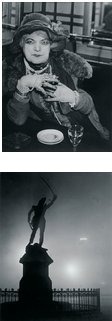Brassai
dal 16/12/2005 al 18/3/2006
Segnalato da
Louisiana Museum of Modern Art
16/12/2005
Brassai
Louisiana Museum of Modern Art, Humlebaek
The Photographer of the Night

The Photographer of the Night
Brassai (1899-1984) is one of the most influential photographers of 20th-century Europe, and has been a great inspiration to many subsequent photographers. Now, for the first time in Denmark, Louisiana is showing a comprehensive presentation of his works with 200 photographs and a selection of his drawings and sculptures. The characteristic, evocative pictures from Parisian night life can be seen in this exhibition alongside other themes that interested the artist in the Paris of the twenties and thirties including the graffiti. The exhibition at Louisiana has been created in close collaboration with the specialist par excellence Alain Sayag/Centre Georges Pompidou, Muse'e national d’art moderne - Centre de Cre'ation Industrielle, Paris, who was also behind the very extensive Brassai exhibition at the Centre Pompidou in 2000.
After Brassai died in 1984 his widow, Mme Gilberte Brassai, presented several hundred of her husband’s original photos, drawings, sculptures, articles and texts to the Centre Georges Pompidou on permanent loan, and it is from this material that the exhibition has been created.
Paris by night as subject
With his camera Brassai wandered the Parisian streets, where he exploited the nocturnal moods and the light from the many street lamps in his pictures. “The night suggests, it does not show. The night disquiets and surprises us with its otherness; it releases forces within us which by day are dominated by reason. I love the wonders of the night, which the light causes to break forth", he said. It is these night pictures that form the focus of the exhibition. But it was not only the atmosphere that interested him. He also focused sharply on the subcultures and the people who had taken up positions on the periphery of the current social morality without romanticizing life in the milieux he encountered, as can be seen for example in a series of intimate photographs from the brothel “Suzy".
“Thanks to endless wandering through Paris it was possible to continue, and to make a kind of social study of the creatures that occupied the city by night. I was familiar with the very lowest strata of society, even the criminals", is how he describes it in the book Le Paris secret des anne'es 30, which appeared in 1976, and in which many of his photographs, stored away for almost forty years, were published for the first time.
One of Brassai’s friends referred him to a publisher who wanted to bring out a book of night pictures from Paris. Brassai was given the task, which resulted in his own first book, Paris de Nuit from 1933, with texts by Paul Morand. It showed how Brassai was not only fascinated aesthetically by the buildings of Paris and the scenery-like, mysterious night atmosphere, but also how as a photographer he took up the technical challenge posed by the extreme light conditions.
In 1932 Brassai’s eyes were opened to a new area: the graffiti on the house walls in Paris - the urban nature with walls that fascinate through their material - the blotches, the mould and the colours. The exhibition shows many of his photographs of the graffiti that is incised in the walls, and the graffiti that is drawn or painted. He was particularly interested in the painted graffiti, which a simple shower of rain could eliminate, and he made systematic records in his small notebooks, where both the places and datings are indicated by each sketch. Some of the first photos were reproduced in the periodical Minotaure and accompanied by an article by Brassai himself with the title “From cave to factory wall".
In 1934, inspired by the graffiti, he embarked on new experiments with photography, which he later called “transmutations". By scratching on the photographic plates he changed the motifs so they appeared as brand new compositions with a different materiality than the photograph. The results are surprising and often ground-breaking for the period.
After a glance around the exhibition one is in no doubt that Brassai was in love with Paris from the second he came to the city, and for most of his career he worked to immortalize it through photos of street life by day and the cafe's and the Seine by night. He experienced the city intensely and saw its face more clearly than others.
Louisiana Museum of Modern Art
Louisiana is situated 35 km north of Copenhagen along the motorway E47 / E55,
or the coast road Strandvejen along the Sound.
Opening hours:
Daily 10.00 - 17.00,
Wednesday 10.00 - 22.00
The Museum is closed on 24, 25 and 31 December,
1 January the Museum opens at 12 noon



